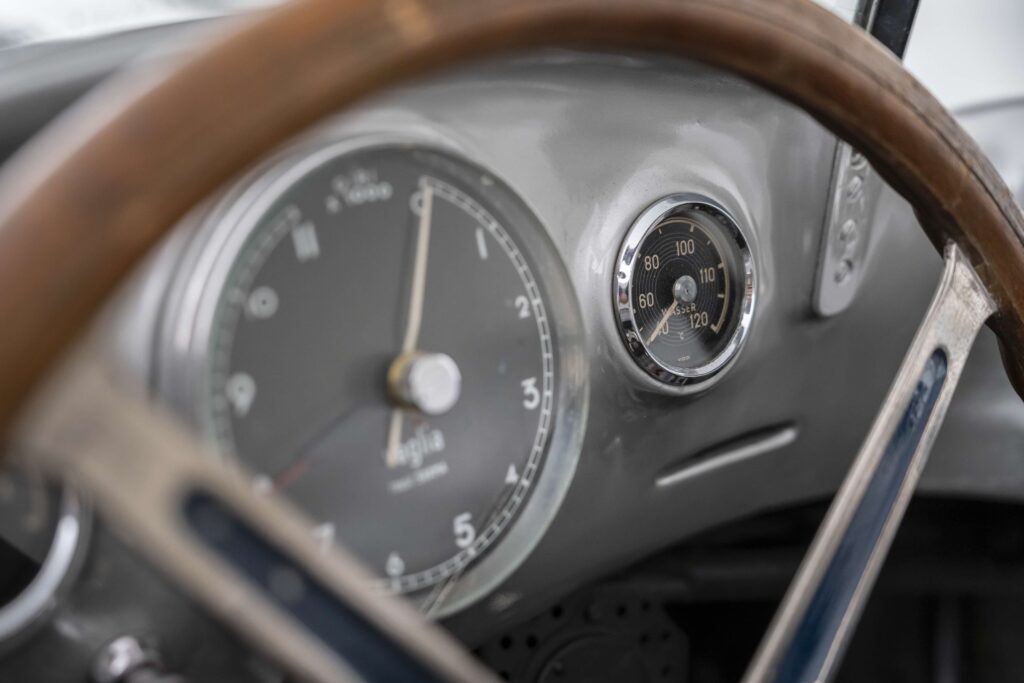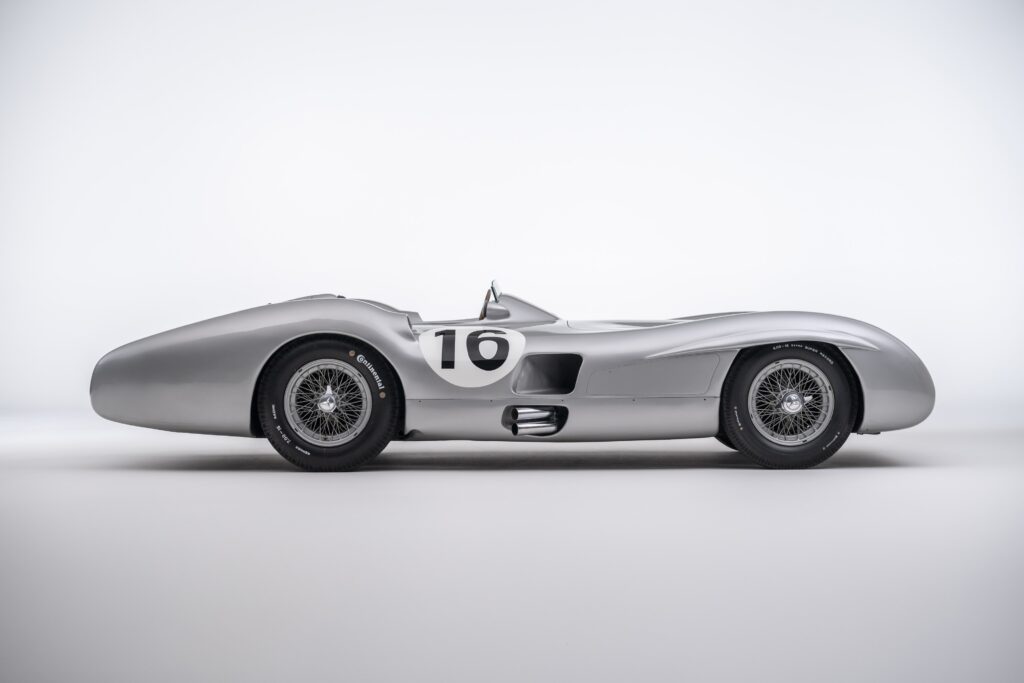Alas, opportunity over. What you see on these pages is the first W 196 R with Streamliner-body ever offered for private ownership. It was recently hammered down at €51,155,000, making it the second most expensive car ever...
Text: Gerben Bijpost Photography: Mercedes-Benz AG
What makes a classic racing car truly legendary? To meet that status, the car has to shine like a diamond. So whatever angle you look at it from, be it its design, its technical aspects, how competitive it was, the races it won, the drivers who drove it, the owners who cherished it after its active career ánd of course its overall looks.
 In terms of all these facets, the brilliance of this 1954 Mercedes-Benz W 196 R Stromlinienwagen (or Streamliner in English) with chassis number 00009/54 is almost dazzling. The 1954 Mercedes-Benz W 196 R Stromlinienwagen is therefore one of the most revolutionary and iconic racing cars in motorsport history.
In terms of all these facets, the brilliance of this 1954 Mercedes-Benz W 196 R Stromlinienwagen (or Streamliner in English) with chassis number 00009/54 is almost dazzling. The 1954 Mercedes-Benz W 196 R Stromlinienwagen is therefore one of the most revolutionary and iconic racing cars in motorsport history.
Let's start the story of this beauty right after World War II. During those years, Mercedes-Benz was not active in motorsport, but was mainly concerned with rebuilding Germany and trying to find a profitable niche in the post-war economy. Like most European brands, this started with cheap and efficient models based on pre-war designs, aimed at the ordinary working man. But gradually Mercedes-Benz began to differentiate itself and came up with more luxurious offerings. In 1951, Stuttgart signalled its intention to resume production of luxury and sports cars, and in 1954 it seized its chance on the highest racing stage.
 In 1952 and 1953, credible competition within Formula 1 was almost non-existent, and to keep the class alive, racing was based on Formula 2 specifications. The FIA therefore decided to draw up new Formula 1 rules, which would take effect for the 1954 season, giving interested manufacturers over a year to develop a suitable race car. The new rules were simple: a normally aspirated engine could not exceed 2.5 litres, a blown engine a maximum of 750cc. Apart from the requirement of one centred seat, just about anything was allowed.
In 1952 and 1953, credible competition within Formula 1 was almost non-existent, and to keep the class alive, racing was based on Formula 2 specifications. The FIA therefore decided to draw up new Formula 1 rules, which would take effect for the 1954 season, giving interested manufacturers over a year to develop a suitable race car. The new rules were simple: a normally aspirated engine could not exceed 2.5 litres, a blown engine a maximum of 750cc. Apart from the requirement of one centred seat, just about anything was allowed.
Mercedes-Benz took this up and then made a spectacular return to Formula 1 with the W 196 R. The streamlined bodywork was unique. Low and wide, with smoothly curved lines and minimal frills. A visual appeal that rivaled the most sensual cars ever. The W 196 R came in two variants: a conventional open-wheel version, better suited to twisty circuits, and the Stromlinienwagen, whose streamlined bodywork was specifically designed for fast circuits with long straights, such as Reims and Monza. The focus was on minimal drag, allowing the car to achieve exceptional top speeds.
 The W 196 R pictured here, with chassis number 00009/54, is altogether a special specimen. It made its debut at the Buenos Aires Grand Prix on 30 January 1955, where it was used in open-wheel configuration. None other than Juan Manuel Fangio, by then a living legend, drove the car to victory.
The W 196 R pictured here, with chassis number 00009/54, is altogether a special specimen. It made its debut at the Buenos Aires Grand Prix on 30 January 1955, where it was used in open-wheel configuration. None other than Juan Manuel Fangio, by then a living legend, drove the car to victory.
The W 196 R's technological innovations made it ahead of its time. It was equipped with a mechanical fuel injection system, a technique derived from the Messerschmitt Bf 109 fighter planes of World War II. This system provided a more efficient fuel supply, resulting in better performance and reliability. The 2.5-litre eight-cylinder in-line engine produced around 290 hp, enabling the car to reach speeds of over 300 km/h. The combination of a lightweight tubular frame, advanced torsion suspension and an aerodynamic body made of a special alloy that was lighter than aluminium gave the car unsurpassed speed and stability on high-speed circuits.
Chassis 00009/54 was converted to Streamliner -i.e. with closed fenders- later in the season and used at the Italian Grand Prix at Monza. This circuit, known for its long straights and high speeds, was perfect for the super-streamlined bodywork. The legendary Stirling Moss, one of the most talented drivers of his generation, took the wheel and set the fastest lap, with an impressive average speed of 215.7 km/h. However, he faced technical problems, eventually finishing seventh.
 The 1955 season proved to be a year of triumph as well as tragedy for Mercedes-Benz. The superior W 196 R scored many victories and at the end of the 1955 Formula 1 season, Fangio notched up his second Formula 1 drivers' title in a row. Moss finished second, sealing the W 196 R's legendary status.
The 1955 season proved to be a year of triumph as well as tragedy for Mercedes-Benz. The superior W 196 R scored many victories and at the end of the 1955 Formula 1 season, Fangio notched up his second Formula 1 drivers' title in a row. Moss finished second, sealing the W 196 R's legendary status.
But this was overshadowed by the Le Mans disaster in June 1955. During this 24 Hours of Le Mans, Pierre Levegh's Mercedes-Benz 300 SLR crashed, leading to a catastrophic chain reaction that killed more than eighty spectators. Following this tragedy, Mercedes-Benz decided to withdraw from motorsport completely at the end of the season and the brand disappeared from the circuits for more than 30 years, only to return in the mid-1980s.
 Chassis number 00009/54 was kept as a historical heirloom after its active racing career. In 1964, the car was donated to the Indianapolis Motor Speedway Museum, where it was cherished for decades and only rarely displayed. But in January of 2025, it was allowed to look for a new owner. The car was auctioned off by RM Sotheby's at the Mercedes-Benz Museum in Stuttgart and raised a record sum of over 51 million euros, making this W 196 R the most expensive Grand Prix car ever. Part of this amount will be used for restoration projects at the Indianapolis Motor Speedway Museum, ensuring that the heritage of historic racing cars like this one is preserved for future generations.
Chassis number 00009/54 was kept as a historical heirloom after its active racing career. In 1964, the car was donated to the Indianapolis Motor Speedway Museum, where it was cherished for decades and only rarely displayed. But in January of 2025, it was allowed to look for a new owner. The car was auctioned off by RM Sotheby's at the Mercedes-Benz Museum in Stuttgart and raised a record sum of over 51 million euros, making this W 196 R the most expensive Grand Prix car ever. Part of this amount will be used for restoration projects at the Indianapolis Motor Speedway Museum, ensuring that the heritage of historic racing cars like this one is preserved for future generations.



